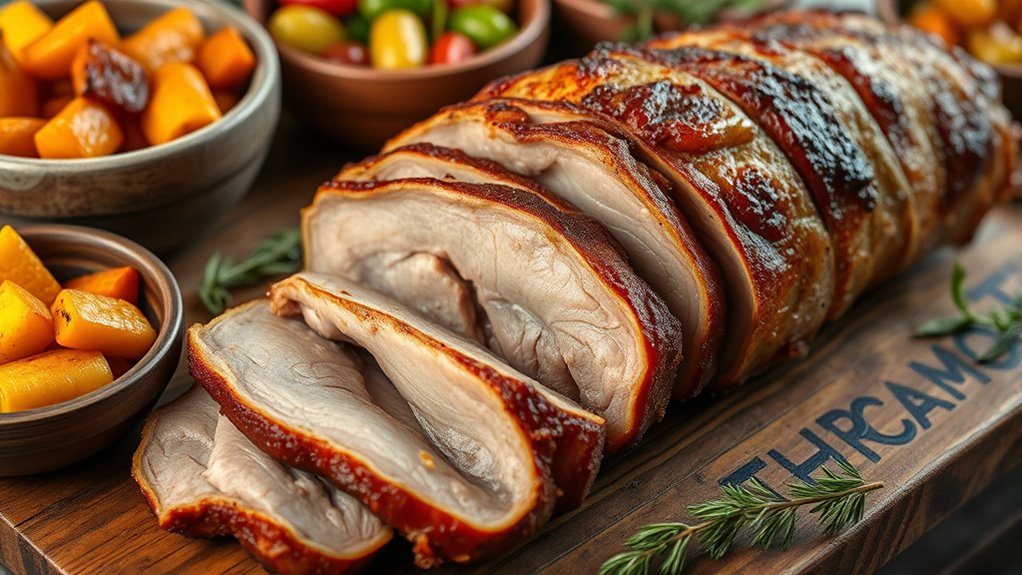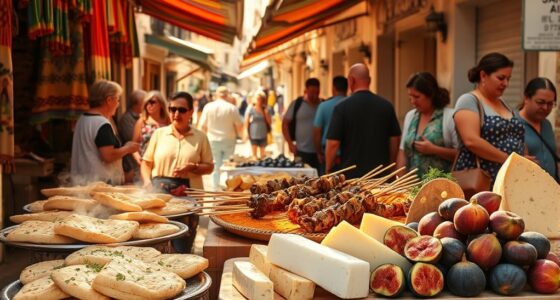Discover the rich world of Sardinian meat dishes, with Porceddu leading the way as a celebrated roasted suckling pig prepared using traditional methods like slow spit-roasting over aromatic woods and herbs. Sardinian cuisine also features regional variations, from inland specialties to coastal flavors, often served during festivals and celebrations that emphasize community and hospitality. If you’re curious about these unique dishes and their cultural significance, there’s plenty more to explore behind Sardinia’s flavorful culinary heritage.
Key Takeaways
- Porceddu, a traditional Sardinian roasted suckling pig, is a cultural emblem prepared over aromatic woods with slow roasting methods.
- Sardinian meat dishes often feature communal sharing, festive significance, and are served with local bread, vegetables, and regional wines.
- Regional variations include the use of herbs like myrtle, rosemary, and fennel, and cooking techniques such as spit-roasting and open fire roasting.
- Other notable Sardinian meat specialties include roasted lamb, goat, and traditional sausages, reflecting the island’s pastoral and agricultural roots.
- Sardinian meat cuisine emphasizes natural ingredients, simple seasoning, and ancient preparation methods rooted in local history and cultural practices.
The Heritage of Sardinian Culinary Traditions
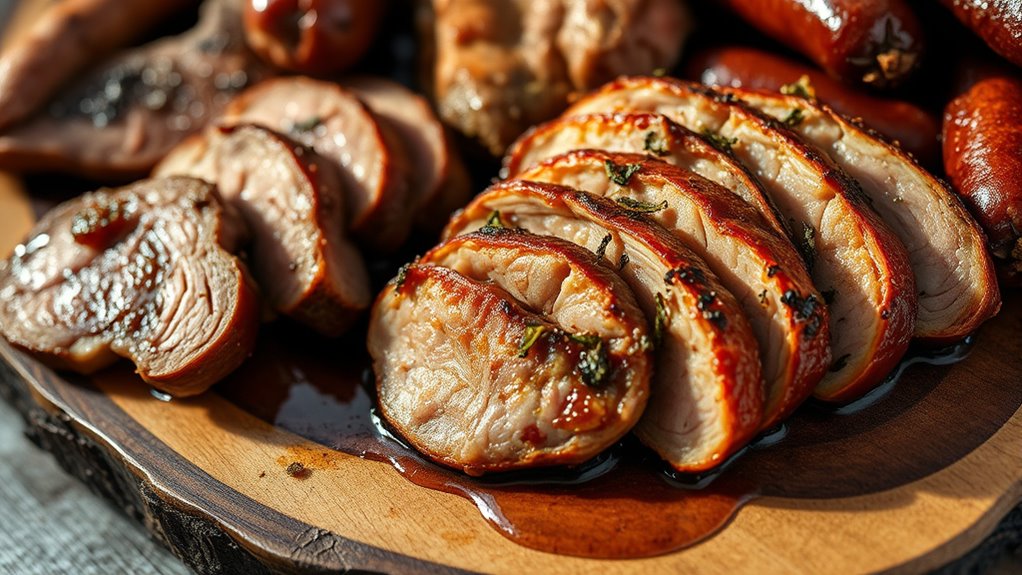
Sardinian culinary traditions have deep roots that trace back to medieval times, shaping the island’s unique food identity. You’ll find that medieval Sardinian cuisine centered around the fireplace, using terracotta and copper pots to boil and roast meat and fish. Spices were skillfully added to boost robust flavors, especially of game meat. Preservation methods relied on salting meat and fish, which kept flavors fresh long before refrigeration. Bread baking has persisted since the Nuragic period, with medieval ovens integral to daily life alongside sheep’s cheese. Influences from Byzantine, Greek, and Latin cultures helped develop agricultural and culinary practices. These traditions emphasize simple, genuine ingredients like lamb, pork, and local herbs, creating a vibrant, enduring food heritage that connects past to present. Additionally, traditional cooking techniques such as slow roasting contribute to the rich flavors that define Sardinian meat dishes.
The Art of Preparing Porceddu
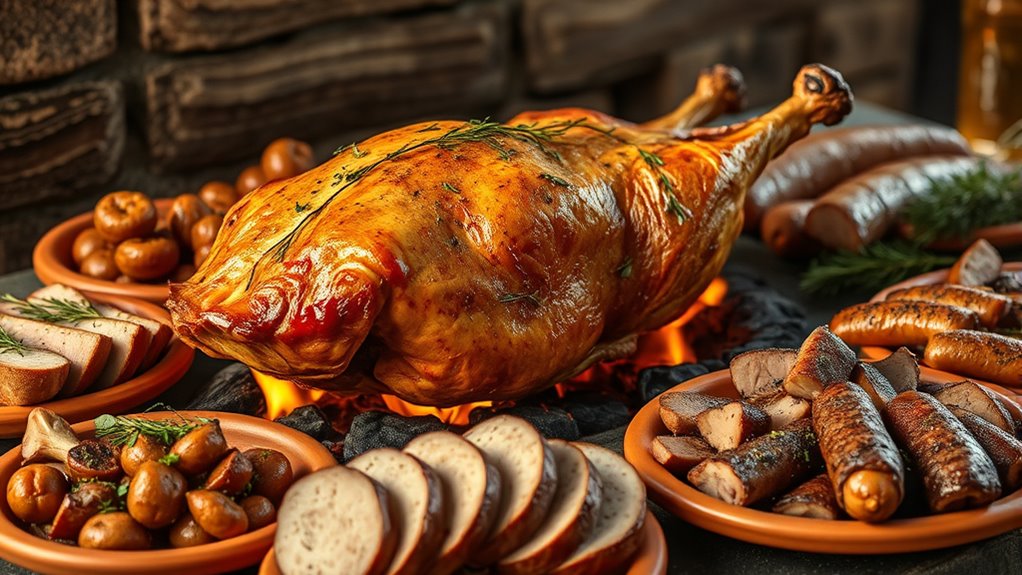
To prepare an authentic Porceddu, you start by choosing a young suckling piglet that’s tender and flavorful, then season it thoroughly with salt and aromatic herbs like myrtle and rosemary. Next, you’ll use traditional spit-roasting techniques over aromatic wood fires, rotating the pig slowly to achieve even cooking and a crispy skin. Properly managing the fire and seasoning guarantees the meat stays juicy and infused with Sardinian flavors. Additionally, understanding the weight of wind turbine blades can inspire sustainable practices in the production of materials used for outdoor cooking equipment.
Selecting the Ideal Piglet
Choosing the right piglet is essential for achieving the perfect Porceddu. You want a young, suckling piglet under 20 days old, weighing between 4 to 6 kg (9 to 13 pounds). This size guarantees tender, juicy meat with a delicate flavor, thanks to milk feeding. Smaller piglets roast more evenly and quickly, making them ideal for traditional methods like spit roasting. Avoid mature pigs, as their meat can become tough and lose the authentic Porceddu character. Select piglets from local breeds raised on natural pastures, fed on their mother’s milk, to assure rich flavor and proper fat content. Ensure the piglet is healthy, clean, and free of impurities before cooking. Proper selection is key to achieving moist, tender meat with crispy skin and authentic Sardinian flavor. Proper piglet selection is crucial in maintaining the traditional quality and taste of Sardinian meat dishes.
Seasoning and Aromatics
Seasoning and aromatics play an essential role in bringing out the authentic flavor of Porceddu without overpowering its natural tenderness. You’ll start with coarse salt, generously applied to enhance the piglet’s delicate, milky taste. Fresh herbs like rosemary and myrtle are key; rosemary adds a piney aroma, while myrtle offers a subtle, sweet herbal note. Sometimes, black pepper is added to balance the richness. During roasting, basting with lard or olive oil helps keep the meat moist and creates a crisp, golden skin. The piglet may be stuffed with myrtle branches, intensifying the aroma internally. These simple, natural ingredients respect the pig’s flavor, allowing the slow roast to develop complex, fragrant layers that celebrate Sardinian culinary tradition. Incorporating traditional seasoning techniques ensures an authentic and balanced flavor profile.
Spit-Roasting Techniques
Preparing a porceddu for spit-roasting begins with selecting a young, milk-fed pig weighing between 4 and 12 kilograms to guarantee tender meat. You’ll need to clean it thoroughly, removing bristles and washing it well. Salt the pig inside and out, applying it twice—before roasting and near the end—to enhance flavor. Stuff the pig with aromatic myrtle branches to infuse fragrance during cooking. Securely skewer it on a sturdy wooden or steel spit, ensuring even rotation. Build an open wood fire with aromatic woods like oak, olive, juniper, or myrtle about a meter in front of the pig. Maintain a consistent heat by adjusting the spit’s distance, and periodically baste with lard or olive oil. Rotate slowly for uniform browning and crisp skin, roasting for 2.5 to 5 hours depending on size. Proper roasting requires attentive monitoring of the fire to maintain the ideal temperature, ensuring the meat remains juicy and flavorful throughout the process.
Key Ingredients and Seasonings

You’ll find that aromatic herbs and simple seasonings define Sardinian meat dishes like Porceddu. Coarse salt, black pepper, and local herbs such as myrtle and rosemary create a signature flavor profile. These ingredients, combined with traditional techniques, highlight the unique and authentic tastes of Sardinian cuisine. Furthermore, these seasonings are integral to the traditional preparation, ensuring the dishes are rich in regional character. Proper meat preparation and seasoning enhance the flavor and authenticity of these dishes.
Aromatic Herb Blends
In Sardinian cuisine, aromatic herb blends play an essential role in creating rich, flavorful dishes that reflect the island’s culinary heritage. Myrtle adds a distinctive, aromatic touch, often used in traditional recipes, while rosemary provides a robust, pine-like aroma that pairs well with meats. Laurel leaves deepen flavors with their subtle bitterness, and sage offers savory richness, especially in roasted dishes. Fennel introduces a sweet, anise-like note, often combined with garlic for added depth. You’ll find herbs like thyme and oregano in seasoning mixes, enhancing meat and pork dishes. Popular combinations include myrtle with rosemary and sage with thyme. These blends are often used as rubs, in stuffing, or as finishing touches, infusing Sardinian meats with authentic, aromatic complexity. Properly applying herb blends can significantly improve the depth and authenticity of traditional Sardinian meat dishes.
Traditional Seasoning Staples
Salt and pepper form the foundation of Sardinian meat seasoning, highlighting the natural flavors of the ingredients. These staples set the stage for more complex seasonings, balancing and enhancing each dish. Here’s what you should remember:
- Salt boosts flavor and balances seasonings, especially in slow-cooked lamb and pork.
- Freshly ground black pepper adds fullness and a robust, mild heat without overpowering.
- Garlic is essential for depth, often minced or crushed, pairing perfectly with pork and lamb.
- Wild fennel seeds offer a sweet, licorice aroma, especially in sausages, adding complexity.
- The use of herbs like rosemary and thyme further complements the meat, creating a fragrant and well-rounded flavor profile unique to Sardinian cuisine.
- Understanding seasoning fundamentals helps you appreciate how these ingredients work together to enhance the meat’s natural richness.
Together, these ingredients create a simple yet effective flavor base that supports Sardinian culinary traditions. They’re used generously but thoughtfully, allowing the meat’s natural richness to shine.
Unique Sardinian Flavors
Unique Sardinian flavors stem from an array of regional herbs, wild aromatics, and carefully chosen seasonings that elevate the island’s meat dishes. You’ll taste wild fennel in sausages, imparting an anise-like note that’s unmistakably Sardinian. Myrtle leaves, traditionally used to wrap porceddu, add a fragrant aroma during slow roasting. Sardinian wild herbs, gathered from the pastoral landscape, bring fresh herbal notes that complement pork and beans. Fresh mint adds a bright contrast in dishes like culurgiones. Regional wines like Cannonau and Vernaccia enhance flavors and tenderize meats, with their fruity, spicy, and acidic profiles. Indigenous ingredients such as pecorino cheese, fregola, and dried chili flakes further define the flavors. These elements create vibrant, rustic profiles that highlight Sardinia’s culinary heritage. Additionally, Sardinian meat dishes often feature traditional cooking methods like slow roasting over open flames or underground pits, which intensify flavors and tenderize the meat, reflecting centuries-old culinary techniques. Incorporating traditional cooking methods such as slow roasting not only enhances taste but also preserves cultural authenticity.
Traditional Cooking Techniques and Methods
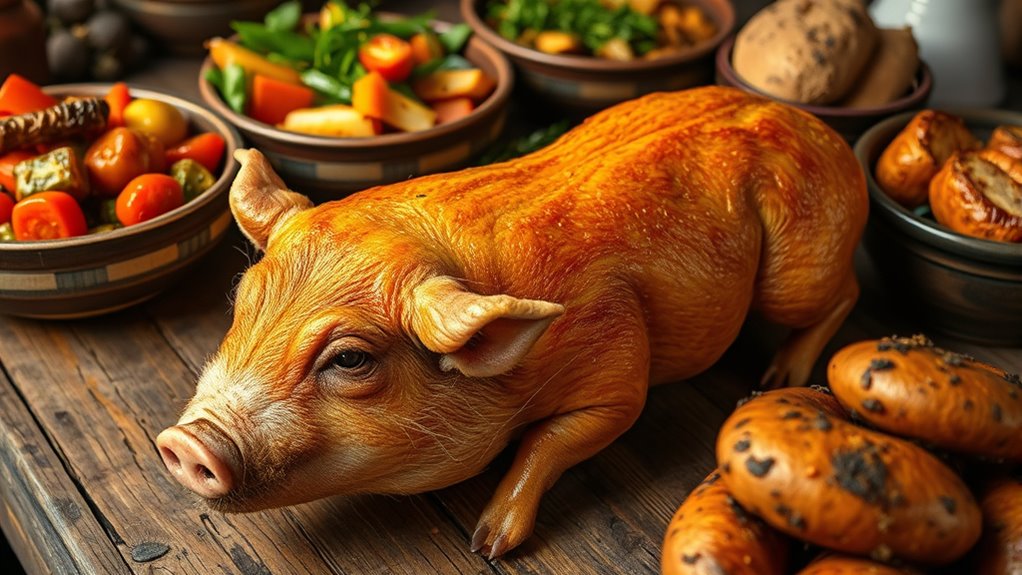
Traditional Sardinian meat dishes rely on time-honored techniques that emphasize slow, even cooking to bring out the tender, flavorful qualities of the meat. When preparing a piglet, you start with selecting young, milk-fed animals weighing 4–6 kg for ideal tenderness. You’ll then clean and season it with salt, herbs like rosemary and fennel, and sometimes lard to keep it moist. Many of these methods have been passed down through generations, preserving the island’s culinary heritage. To enhance the flavor, some cooks incorporate heritage culinary techniques such as using aromatic woods or herbs during roasting. 1. Skewer the piglet on a spit or lay it in a pit surrounded by aromatic leaves. 2. Roast it slowly over an open fire, turning it regularly for uniform cooking. 3. Gradually bring the roast closer to the flames to develop a crispy, golden skin. 4. Check for doneness by piercing the thigh, ensuring the meat is hot and succulent.
The Role of Wood and Smoke in Flavor Development
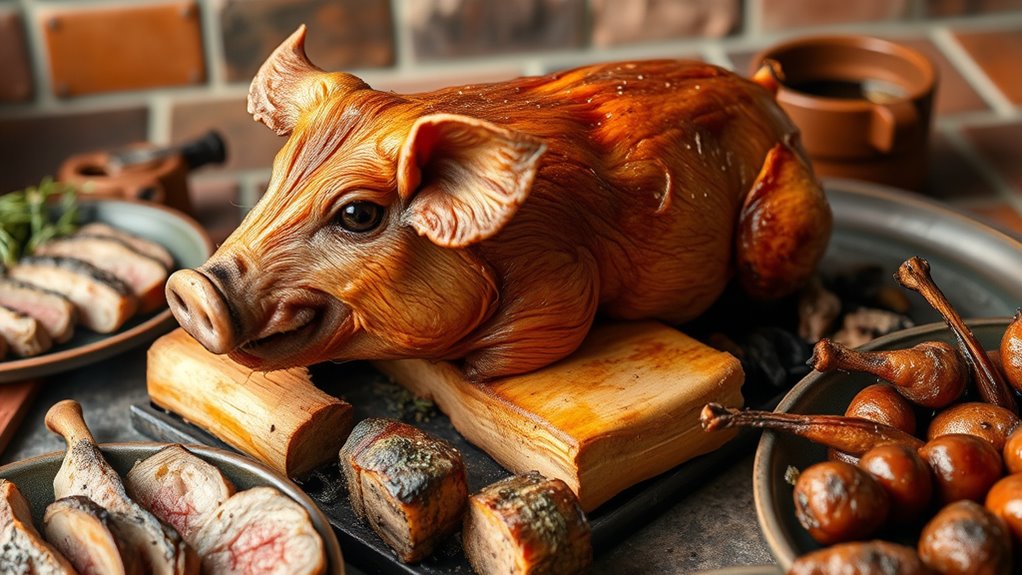
Wood and smoke play a crucial role in shaping the flavor of Sardinian Porceddu, as the choice of aromatic woods directly influences the meat’s aroma and taste. You’ll notice that local woods like juniper, myrtle, olive, arbutus, and oak are used to build the fire, each imparting distinct resinous and herbal notes. Periodically adding dried herb twigs, soaked beforehand, creates flavorful smoke that infuses the meat with complex scents of pine, myrtle, and herbs. This slow, steady smoke permeates the piglet over 3-6 hours, developing a savory fragrance and forming a crispy, browned exterior. The smoke acts as a natural marinade, enhancing juiciness and flavor, while also contributing to the dish’s regional signature and rustic character.
Regional Variations and Local Customs

The flavors and aromas of Sardinian Porceddu are shaped not only by the fire and smoke but also by regional customs and local ingredients. You’ll notice differences like:
- In Ogliastra, locals use herbs like myrtle for seasoning, tying tradition to local flora.
- Barbagia adds parsley or chives, creating herb variation that reflects local tastes.
- The Campidano region sometimes incorporates saffron, showcasing spice diversity in southern Sardinia.
- Coastal areas prefer aromatic woods like olive or oak, while inland regions use juniper or myrtle branches for distinctive aromas.
- The traditional preparation methods also vary, with some areas favoring slow roasting over open flames, while others use enclosed ovens to influence the final flavor profile. These methods are deeply rooted in regional culinary traditions, which highlight the cultural importance of Porceddu during festivals and communal gatherings.
Serving Styles and Accompaniments
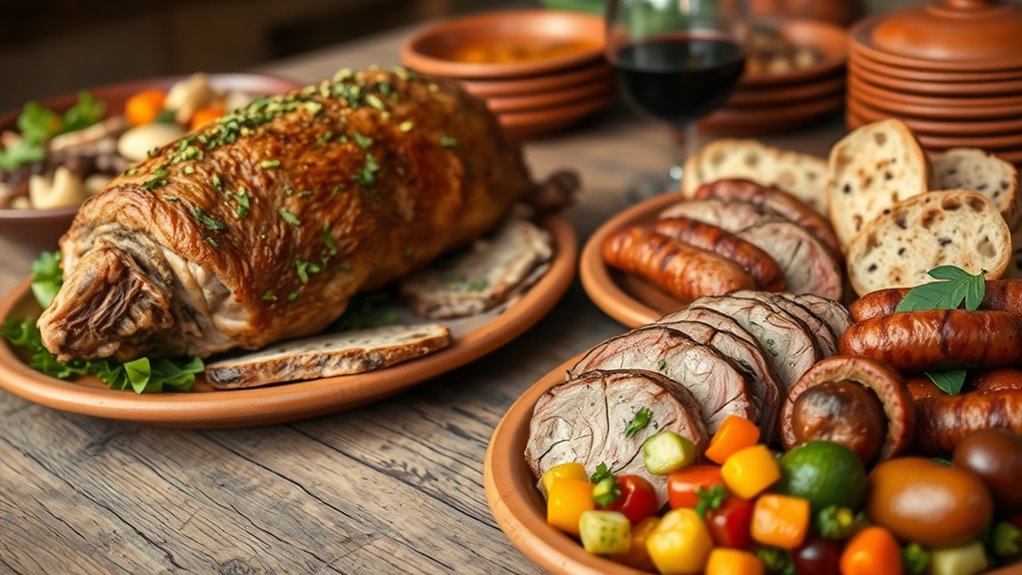
When serving Porceddu, it’s common to present the roasted pig on a large wooden board or platter, creating a communal and rustic display that invites sharing. The skin remains crispy and golden, while the meat is carved tableside or by the host to preserve freshness. Garnished with aromatic herbs like myrtle or rosemary, the presentation emphasizes Sardinian hospitality. Accompaniments typically include roasted potatoes seasoned with herbs and olive oil, local vegetables such as artichokes or fennel, and traditional breads like pane carasau or pane guttiau. These elements balance the richness of the pork. Beverages such as Cannonau wine or Mirto liqueur are served to complement the flavors. The style reflects festive, outdoor gatherings, emphasizing sharing, tradition, and rustic elegance.
| Presentation | Side Dishes | Beverages |
|---|---|---|
| Wooden platter | Roasted potatoes | Cannonau wine |
| Garnished with herbs | Local vegetables (artichokes) | Mirto liqueur |
| Carved tableside | Sardinian breads | Sparkling water |
Selecting the Perfect Piglet for Porceddu

Choosing the right piglet is essential for achieving authentic Porceddu. To guarantee tender, flavorful meat, focus on these key factors:
- Age and Weight: Select piglets between newborn and 20 days old, weighing 4-6 kg, for ideal tenderness and even cooking.
- Diet and Rearing: Ensure they are still suckling on mother’s milk, raised naturally on pasture with herbs, avoiding commercial feeds that could compromise flavor.
- Physical Health: Look for healthy piglets with clear eyes, pink skin, and balanced fat distribution; skin should be intact without blemishes.
- Selection Practice: Trust local experts who use traditional visual and tactile methods, often tied to cultural or seasonal timing to pick the best candidates.
Proper selection guarantees juicy, tender meat with the signature crispy skin of a perfect Porceddu. Additionally, understanding Sardinian culinary traditions helps appreciate the significance of selecting the right piglet for this iconic dish.
Celebratory Occasions and Cultural Significance

Selecting the perfect piglet sets the foundation for an authentic Porceddu, but its significance goes far beyond the meat itself. You’ll find this dish at Sardinian festivals, village celebrations, weddings, and religious events, where it plays a central role. During communal feasts, Porceddu fosters a sense of unity and hospitality, connecting families and villages. Its origins trace back to nuragic times, symbolizing Sardinian identity and tradition. The preparation, involving slow roasting over wood fires with aromatic herbs, highlights cultural heritage. Serving Porceddu on myrtle leaves and sharing it among guests emphasizes Sardinian warmth and communal spirit. More than a meal, it’s a symbol of festivity, cultural pride, and the enduring bond within Sardinian communities.
Frequently Asked Questions
What Is the Ideal Weight for a Piglet Used in Porceddu?
The ideal weight for a piglet depends on your cooking style, but generally, you want one between 4 to 6 kg (8 to 13 lbs) for perfect roasting. If you choose a larger piglet, like 8 to 10 kg, it can still work but requires longer cooking and careful attention. Smaller piglets roast faster and give a more delicate flavor, so pick based on your preferred texture and roasting method.
How Long Does the Entire Porceddu Roasting Process Typically Take?
The entire porceddu roasting process usually takes about 4 to 5 hours, depending on the piglet’s size and cooking method. You start with preparation, which includes seasoning and setting up the fire, then proceed to roasting, turning the pig regularly for even cooking and crispy skin. After roasting, you might let it rest for flavors to settle. Overall, plan for several hours of active and passive cooking time.
What Types of Wood Are Best for Flavoring the Smoke?
Think of selecting wood for smoking like choosing the perfect brush for painting; it sets the tone. You should use juniper and myrtle for their fragrant, mildly resinous notes that enhance pork’s flavor. Olive wood adds a Mediterranean aroma, while oak provides a deep smokiness. Mixing these woods creates layered flavors. Avoid softwoods like pine, which can ruin the dish, and source local varieties for authenticity.
Can Porceddu Be Prepared Using Modern Cooking Appliances?
You can definitely prepare Porceddu using modern appliances. Using a rotisserie oven or electric spit roaster, you can replicate traditional slow-cooking methods, ensuring even rotation and heat. Baste with olive oil or lard to get that crispy skin, and season with herbs like rosemary. While achieving the smoky aroma is tricky without special equipment, adding wood chips or herbal infusions can help. Just monitor temperature and cooking time carefully for authentic results.
What Are Common Regional Variations of Porceddu Across Sardinia?
Imagine a tapestry woven with regional threads—each area adding its own flavor to the classic porceddu. Across Sardinia, you’ll find variations in seasoning, like herbs and aromatic woods, that paint each dish with a unique hue. Some regions favor stuffing with myrtle branches, others emphasize different basting oils. Cooking techniques shift from open spit roasts to modern ovens, but the heart remains: a celebration of tradition and local character in every bite.
Conclusion
As you explore Sardinian meat dishes like porceddu, you’ll discover a rich tapestry of tradition and flavor that gently invites you into a world of culinary artistry. Each bite carries whispers of history, craftsmanship, and local customs, making every meal a delightful celebration. Embrace these flavors with an open heart, and let the subtle magic of Sardinian cooking softly leave a lasting impression on your palate and soul.
